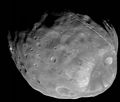Berkas:Phobos colour 2008.jpg

Tu'udu lo'u diipo mopobilohu: 636 x 600 piksel resolusi uweewo:255 x 240 piksel | 509 x 480 piksel | 815 x 768 piksel | 1.086 x 1.024 piksel | 2.172 x 2.048 piksel | 3.500 x 3.300 piksel
Berkas asli (3.500 x 3.300 piksel, tu'udu berkas:2,72 MB, MIME tipe: image/jpeg)
Riwāyati lo berkas
Klik to tanggal/wakutu momilohe berkas to saa'ati botiye.
| Tanggal/Wakutu | Gambari kiki'o | Dimensi | Ta ohu'uwo | Lo'iya | |
|---|---|---|---|---|---|
| baharu | 2 April 2018 11.10 |  | 3.500 × 3.300 (2,72 MB) | Kaldari | more margin on right side |
| 13 Nopember 2008 12.47 |  | 3.374 × 3.300 (2,7 MB) | Fir0002 | == Summary == {{Information |Description=Colour image of Phobos, imaged by the Mars Reconnaisance Orbiter in 2008 |Source=NASA |Date=9 April 2008 |Location=http://www.nasa.gov/mission_pages/MRO/multimedia/pia10368.html |Author=NASA/J |
Berkas u pilopohuna
Halaman botiya lopohuna berkas:
Pilopohuna berkas global
Wiki uweewo hemomake berkas botiya
- Pilopohuna to af.wikipedia.org
- Pilopohuna to an.wikipedia.org
- Pilopohuna to ar.wikipedia.org
- المريخ
- فوبوس
- قمرا المريخ
- ويكيبيديا:صور مختارة/الفضاء والكون/نظرة إلى الأعلى
- قائمة أجرام المجموعة الشمسية مرتبة حسب الحجم
- بوابة:علم الفلك/صورة مختارة
- بوابة:المريخ
- بوابة:المريخ/مقالة مختارة/أرشيف
- بوابة:المريخ/مقالة مختارة/2
- قائمة الأقمار الطبيعية
- خط زمني لاكتشاف كواكب المجموعة الشمسية وأقمارها
- ويكيبيديا:ترشيحات الصور المختارة/القمر فوبوس
- ويكيبيديا:صورة اليوم المختارة/أغسطس 2019
- قالب:صورة اليوم المختارة/2019-08-03
- بوابة:علم الفلك/صورة مختارة/73
- معسكر قاعدة المريخ
- ويكيبيديا:صورة اليوم المختارة/يناير 2022
- قالب:صورة اليوم المختارة/2022-01-04
- Pilopohuna to ary.wikipedia.org
- Pilopohuna to arz.wikipedia.org
- Pilopohuna to as.wikipedia.org
- Pilopohuna to azb.wikipedia.org
- Pilopohuna to az.wikipedia.org
- Pilopohuna to be-tarask.wikipedia.org
- Pilopohuna to be.wikipedia.org
- Pilopohuna to bg.wikipedia.org
- Pilopohuna to bh.wikipedia.org
- Pilopohuna to bn.wikipedia.org
- Pilopohuna to bn.wikibooks.org
- Pilopohuna to bs.wikipedia.org
Bilohi ngohuntuwa ta lopohuna global lo berkas botiye.





